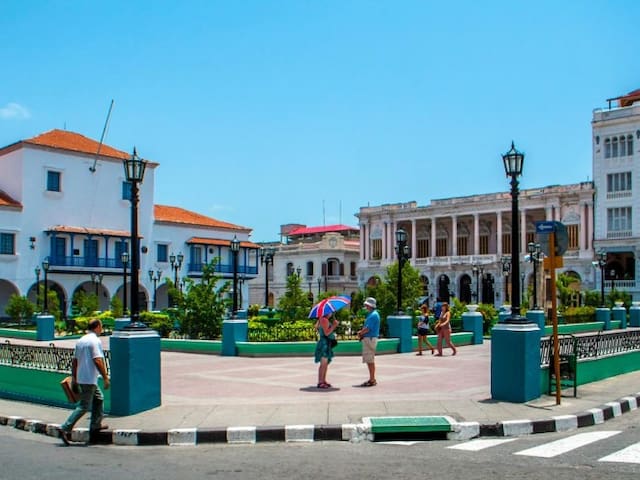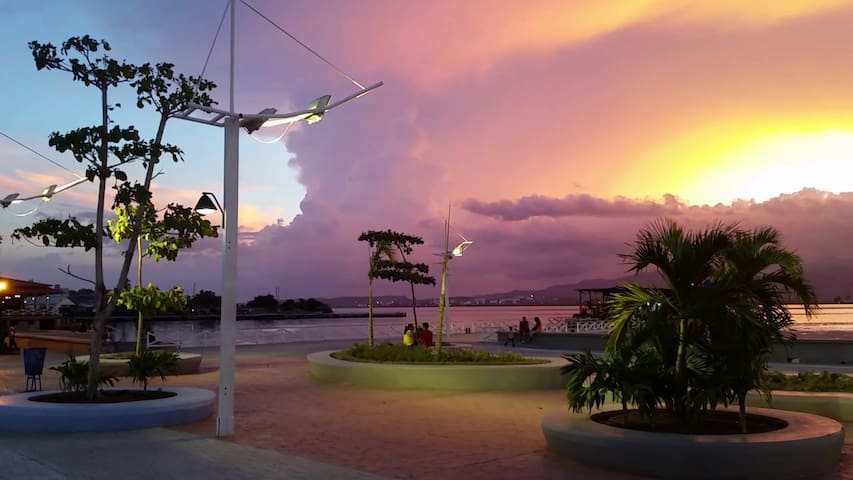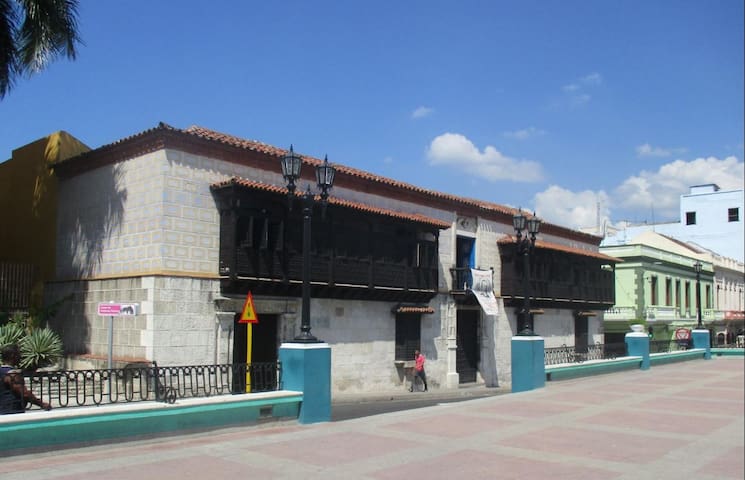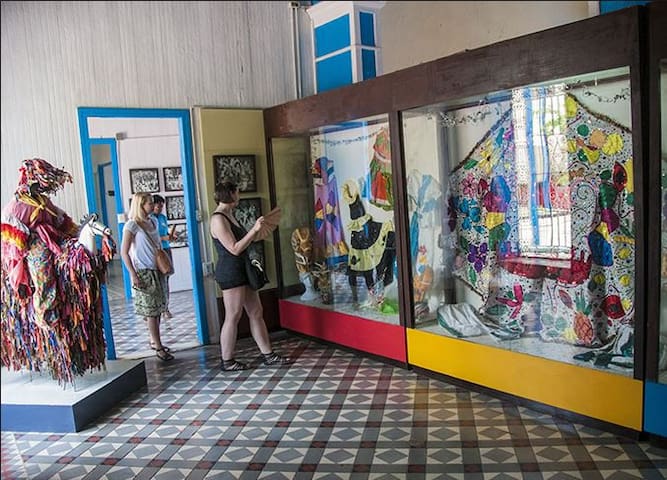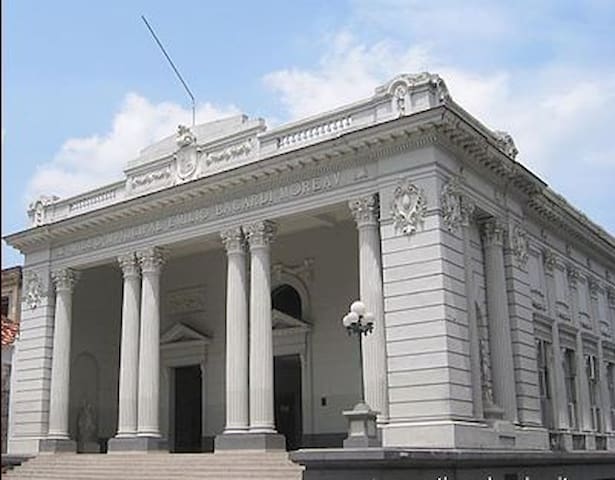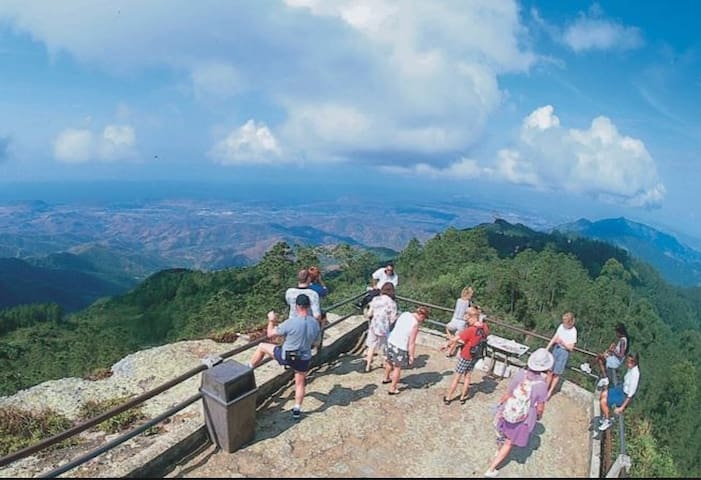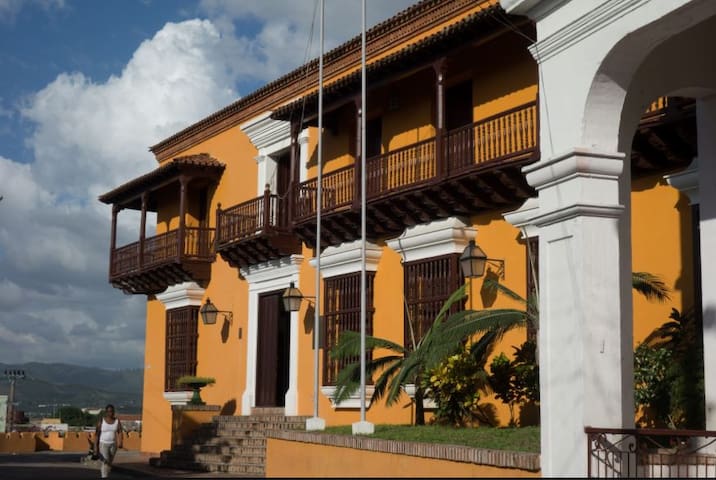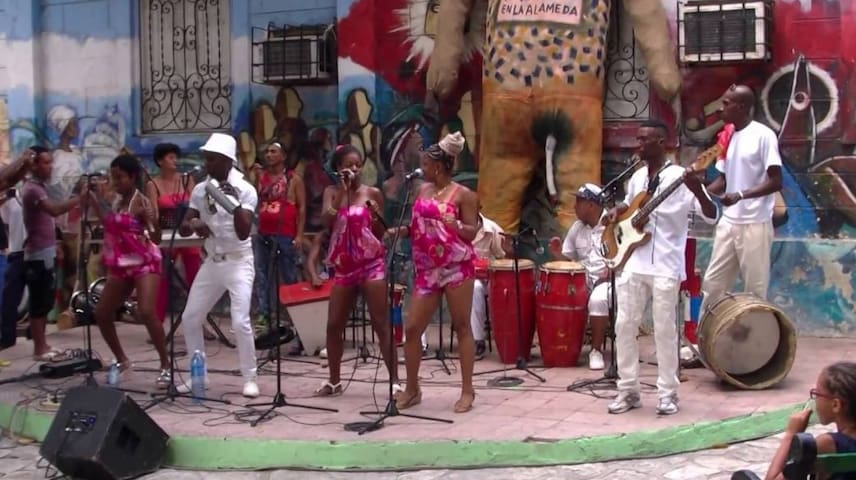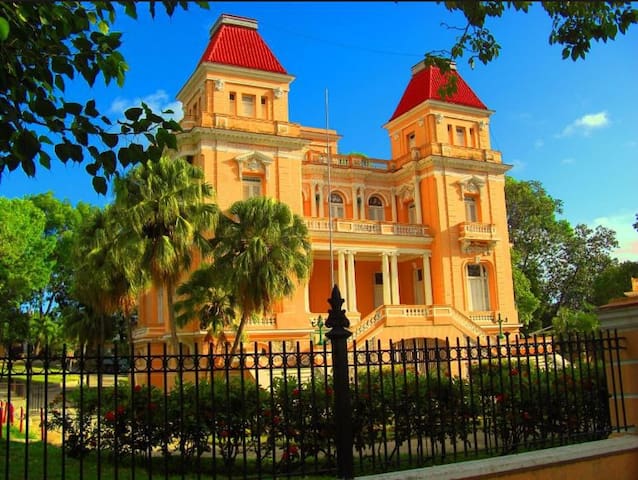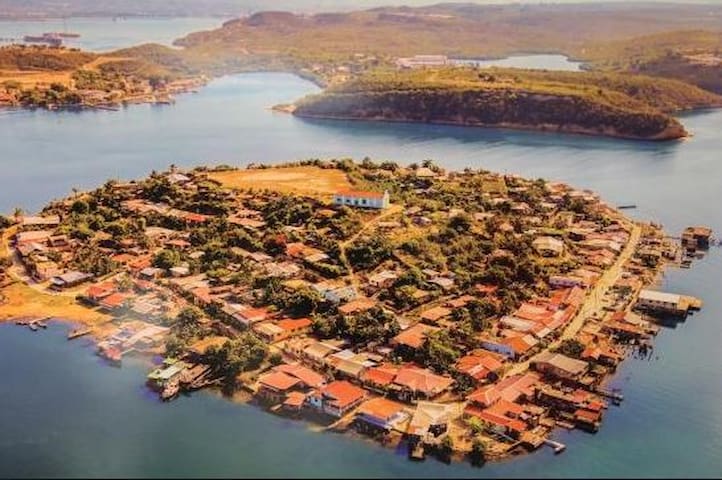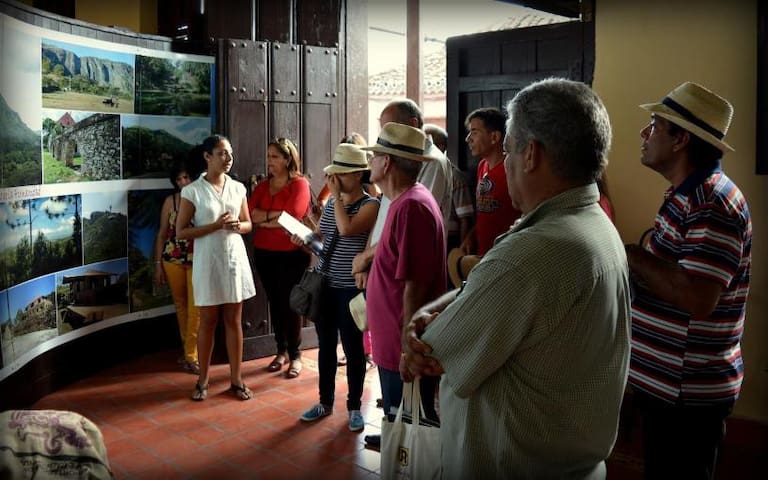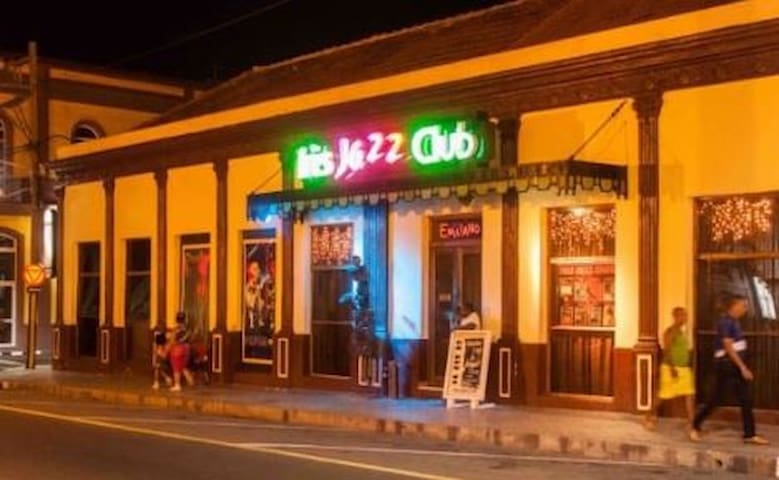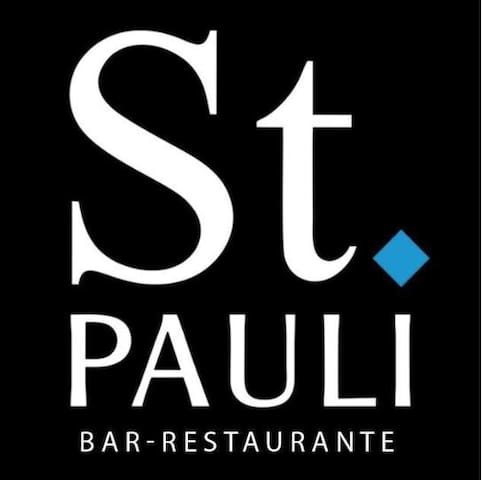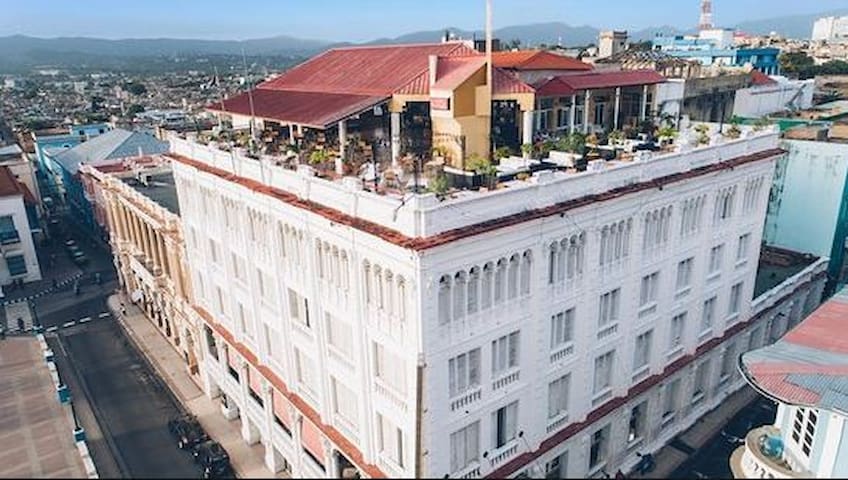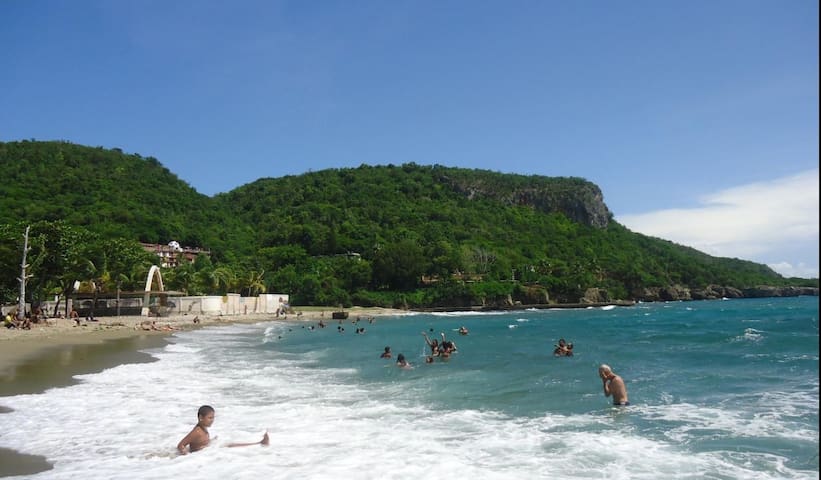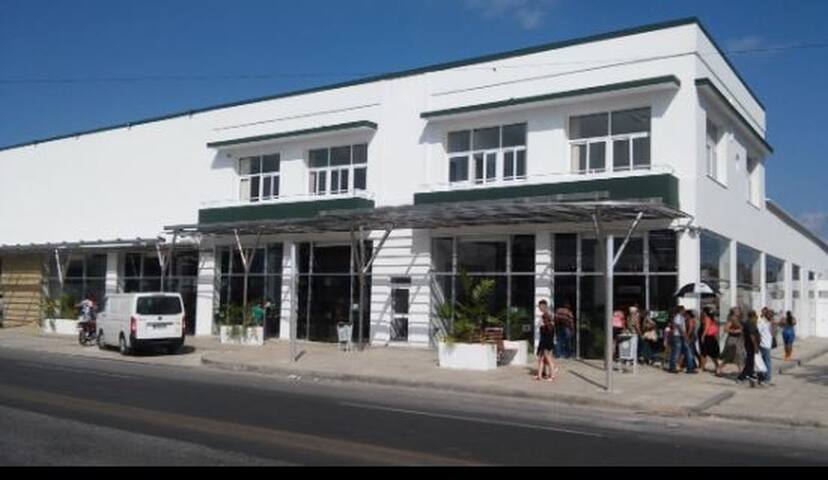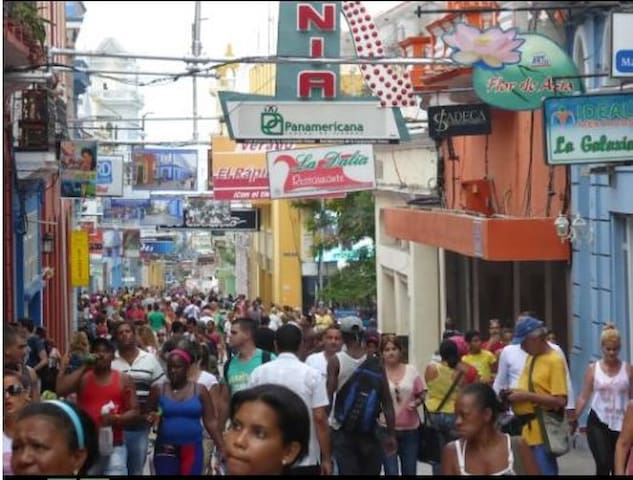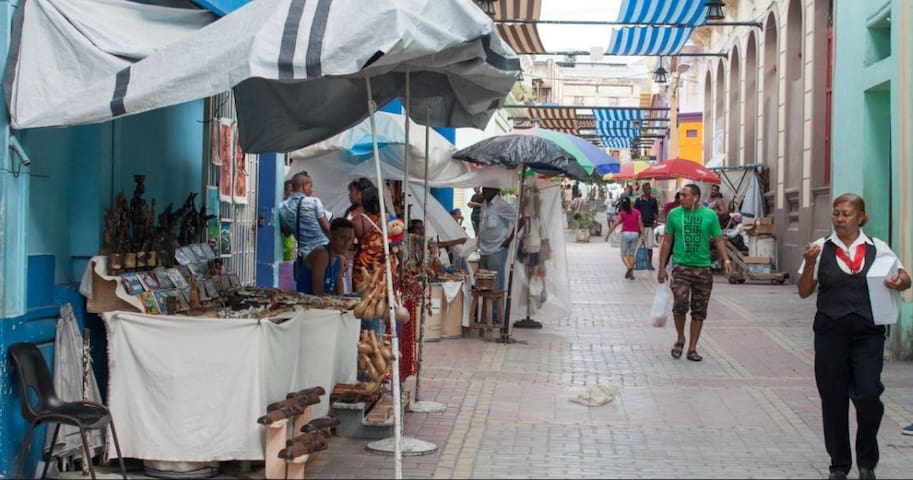Sights
A Unesco World Heritage Site since 1997, the San Pedro fort sits impregnably atop a 60m-high promontory at the entrance to Santiago harbor, 10km southwest of the city. The stupendous views from the upper terrace take in the wild western ribbon of Santiago's coastline backed by the velvety Sierra Maestra.
55 locals recommend
San Pedro de la Roca Castle
A Unesco World Heritage Site since 1997, the San Pedro fort sits impregnably atop a 60m-high promontory at the entrance to Santiago harbor, 10km southwest of the city. The stupendous views from the upper terrace take in the wild western ribbon of Santiago's coastline backed by the velvety Sierra Maestra.
The most important shrine for Cubans and most famous church in the country is lodged in the foothills of the Sierra Maestra near the old copper mines that give it its name. The triple-domed church with the mouthful name of El Sanctuario de Nuestra Señora de la Caridad del Cobre, built in 1927, rises on Maboa hill and is photogenically framed by green forest. The faithful come from across Cuba on pilgrimages to pay their respects to (and ask for protection from) a black Madonna, the Virgen de la Caridad (Virgin of Charity).
14 locals recommend
El Cobre, Cuba
The most important shrine for Cubans and most famous church in the country is lodged in the foothills of the Sierra Maestra near the old copper mines that give it its name. The triple-domed church with the mouthful name of El Sanctuario de Nuestra Señora de la Caridad del Cobre, built in 1927, rises on Maboa hill and is photogenically framed by green forest. The faithful come from across Cuba on pilgrimages to pay their respects to (and ask for protection from) a black Madonna, the Virgen de la Caridad (Virgin of Charity).
Visit the Rum Museum and find out all the aspects surrounding the sugar industry and the collection of the spirit from there. In the museum, you will travel through the history of the Cuban rum in a stroll along the halls. Let yourself be led to know all the secrets of the well-known traditional spirit of the Caribbean country.
Museo del Ron Santiago de Cuba
103 PeralejoVisit the Rum Museum and find out all the aspects surrounding the sugar industry and the collection of the spirit from there. In the museum, you will travel through the history of the Cuban rum in a stroll along the halls. Let yourself be led to know all the secrets of the well-known traditional spirit of the Caribbean country.
éspedes Park is the main square of Santiago de Cuba, and, as such, bursts with life and joy from morning until evening, although activity gradually increases as it gets dark.
127 locals recommend
Céspedes Park
éspedes Park is the main square of Santiago de Cuba, and, as such, bursts with life and joy from morning until evening, although activity gradually increases as it gets dark.
Below the Tivolí quarter, this narrow park embellishes a dockside promenade opened in 1840 and redesigned in 1893. Recent refurbishment for the 2015 quincentennial has made it the center of the Malecón (boardwalk) in the style of Havana's, also featuring a playground, palm trees and public wi-fi. The north end features the old clock tower, aduana (customs house) and cigar factory. With smart architecture, sea air and a dash of port-side sketchiness, it's good for a stroll.
7 locals recommend
Parque Alameda
Below the Tivolí quarter, this narrow park embellishes a dockside promenade opened in 1840 and redesigned in 1893. Recent refurbishment for the 2015 quincentennial has made it the center of the Malecón (boardwalk) in the style of Havana's, also featuring a playground, palm trees and public wi-fi. The north end features the old clock tower, aduana (customs house) and cigar factory. With smart architecture, sea air and a dash of port-side sketchiness, it's good for a stroll.
The Moncada Barracks was a military barracks in Santiago de Cuba, named after the General Guillermón Moncada, a hero of the Cuban War of Independence. On 26 July 1953, the barracks was the site of an armed attack by a small group of revolutionaries led by Fidel Castro. This armed attack is widely accepted as the beginning of the Cuban Revolution. The date on which the attack took place, 26 July, was adopted by Castro as the name for his revolutionary movement (Movimiento 26 Julio or M 26-7) which eventually toppled the dictatorship of Fulgencio Batista on 12 January 1959. In 1978, Castro ordered the massive perimeter walls rebuilt and converted half of the main building into July 26 Historical Museum
73 locals recommend
Cuartel de Moncada
Avenida MoncadaThe Moncada Barracks was a military barracks in Santiago de Cuba, named after the General Guillermón Moncada, a hero of the Cuban War of Independence. On 26 July 1953, the barracks was the site of an armed attack by a small group of revolutionaries led by Fidel Castro. This armed attack is widely accepted as the beginning of the Cuban Revolution. The date on which the attack took place, 26 July, was adopted by Castro as the name for his revolutionary movement (Movimiento 26 Julio or M 26-7) which eventually toppled the dictatorship of Fulgencio Batista on 12 January 1959. In 1978, Castro ordered the massive perimeter walls rebuilt and converted half of the main building into July 26 Historical Museum
Built in 1516 and one of the oldest houses in Latin America, the Casa de Diego Velázquez boasts sober lines enlivened by a superb loggia with lattice screens. Inside, the Museo de Ambiente Histórico Cubano exhibits a rich collection of furniture dating from the 17C to 19C, presented in chronological order so that visitors can follow the evolution of the Spanish style into something uniquely Cuban.
83 locals recommend
Casa de Diego Velazquez
Francisco Vicente AguileraBuilt in 1516 and one of the oldest houses in Latin America, the Casa de Diego Velázquez boasts sober lines enlivened by a superb loggia with lattice screens. Inside, the Museo de Ambiente Histórico Cubano exhibits a rich collection of furniture dating from the 17C to 19C, presented in chronological order so that visitors can follow the evolution of the Spanish style into something uniquely Cuban.
This museum will inspire visitors to return to Santiago in July to participate in the carnival. Its history is traced using photos, press cuttings, models, costumes, flags, cabezones (large heads in papier mache), along with instruments used in the processions: drums, tumbas, chachá, maracas and metal percussion. The visit concludes with a folklore display in the patio courtyard
42 locals recommend
Museo del Carnaval
HerediaThis museum will inspire visitors to return to Santiago in July to participate in the carnival. Its history is traced using photos, press cuttings, models, costumes, flags, cabezones (large heads in papier mache), along with instruments used in the processions: drums, tumbas, chachá, maracas and metal percussion. The visit concludes with a folklore display in the patio courtyard
Opened by Santiago's first republican mayor, Emilio Bacardí, this museum highlights the history of the province. History and ethnography are showcased primarily by native Indian (shrunken heads and Peruvian mummies) and Egyptian exhibits (base of a sarcophagus and funerary art). Another section is devoted to Spanish artists. Lastly, the museum also displays paintings from Santiago de Cuba and around the country, including numerous works by the landscape artist José Joaquín Tejada.
29 locals recommend
Museo Emilio Bacardí Moreau
Francisco Vicente AguileraOpened by Santiago's first republican mayor, Emilio Bacardí, this museum highlights the history of the province. History and ethnography are showcased primarily by native Indian (shrunken heads and Peruvian mummies) and Egyptian exhibits (base of a sarcophagus and funerary art). Another section is devoted to Spanish artists. Lastly, the museum also displays paintings from Santiago de Cuba and around the country, including numerous works by the landscape artist José Joaquín Tejada.
La Gran Piedra – The Big Rock – is precisely that: a giant volcanic rock soaring to 1200 meters above sea level in Santiago de Cuba province. It is habitat to an amazing diversity of flora and fauna, making it a brilliant outing for nature enthusiasts.
43 locals recommend
Gran Piedra
La Gran Piedra – The Big Rock – is precisely that: a giant volcanic rock soaring to 1200 meters above sea level in Santiago de Cuba province. It is habitat to an amazing diversity of flora and fauna, making it a brilliant outing for nature enthusiasts.
This gorgeous yellow colonial-style building houses a museum detailing the underground struggle against Batista in the 1950s. It's a fascinating, if bloody, story enhanced by far-reaching views from the balcony.
24 locals recommend
Museo de La Lucha Clandestina
Santa RitaThis gorgeous yellow colonial-style building houses a museum detailing the underground struggle against Batista in the 1950s. It's a fascinating, if bloody, story enhanced by far-reaching views from the balcony.
This vast square can accommodate 20 000 people. At the centre, a huge statue of Antonio Maceo encourages the masses to join the battle. This monument made from 23 iron bars representing machetes recalls the 23 March 1878, the date of the Protesta de Baraguá. Beneath it, the Memorial to Antonio Maceo retraces the life of this hero of Cuba's independence.
37 locals recommend
Plaza de la Revolución
This vast square can accommodate 20 000 people. At the centre, a huge statue of Antonio Maceo encourages the masses to join the battle. This monument made from 23 iron bars representing machetes recalls the 23 March 1878, the date of the Protesta de Baraguá. Beneath it, the Memorial to Antonio Maceo retraces the life of this hero of Cuba's independence.
Founded in 1982 to study Caribbean life, this cultural institution organizes the Festival del Caribe and the Fiesta del Fuego every July and also hosts various concert nights. Interested parties can organize percussion courses or studies in Afro-Cuban culture.
11 locals recommend
Casa Del Caribe
Founded in 1982 to study Caribbean life, this cultural institution organizes the Festival del Caribe and the Fiesta del Fuego every July and also hosts various concert nights. Interested parties can organize percussion courses or studies in Afro-Cuban culture.
Santiago's most important church is stunning both inside and out. There has been a cathedral on this site since the city's inception in the 1520s, though a series of pirate raids, earthquakes and dodgy architects put paid to at least three previous incarnations. The present cathedral, characterized by its two neoclassical towers, was completed in 1922; the remains of first colonial governor, Diego Velázquez, are still buried underneath.
92 locals recommend
Catedral
Santo TomásSantiago's most important church is stunning both inside and out. There has been a cathedral on this site since the city's inception in the 1520s, though a series of pirate raids, earthquakes and dodgy architects put paid to at least three previous incarnations. The present cathedral, characterized by its two neoclassical towers, was completed in 1922; the remains of first colonial governor, Diego Velázquez, are still buried underneath.
This eclectic mansion (built 1906–10) was once the largest and most opulent in Santiago. Since 1974 it has been a developmental center for kids (pioneros). In the garden is an old MiG fighter plane on which the younger pioneers play. The traffic circle at the corner of Av Manduley and Calle 13 contains an impressive marble statue of poet José María Heredia y Heredia.
Palacio de Pioneros
Avenida ManduleyThis eclectic mansion (built 1906–10) was once the largest and most opulent in Santiago. Since 1974 it has been a developmental center for kids (pioneros). In the garden is an old MiG fighter plane on which the younger pioneers play. The traffic circle at the corner of Av Manduley and Calle 13 contains an impressive marble statue of poet José María Heredia y Heredia.
A small, populated key near the jaws of the bay, Cayo Granma is a little fantasy island of red-roofed wooden houses – many of them on stilts above the water – that guard a traditional fishing community. You can hike up to the small whitewashed Iglesia de San Rafael at the key's highest point, or walk around the whole island in 15 minutes. To get to the key, take the regular ferry (leaving every one to 1½ hours) from Punta Gorda just below El Morro fort. The boat stops en route at La Socapa (actually still the mainland; the western jaw of the Bahia de Santiago) where there are decent swimming beaches.
8 locals recommend
Cayo Granma
A small, populated key near the jaws of the bay, Cayo Granma is a little fantasy island of red-roofed wooden houses – many of them on stilts above the water – that guard a traditional fishing community. You can hike up to the small whitewashed Iglesia de San Rafael at the key's highest point, or walk around the whole island in 15 minutes. To get to the key, take the regular ferry (leaving every one to 1½ hours) from Punta Gorda just below El Morro fort. The boat stops en route at La Socapa (actually still the mainland; the western jaw of the Bahia de Santiago) where there are decent swimming beaches.
The Interpretation and Information Centre for Coffee Plantation Cultural Heritage (Centro de Interpretación y Divulgación del Patrimonio Cultural Cafetalero) housed in Casa Dranguet, was fundamentally created to provide information on, and primarily promote, coffee-related culture around the world, in Cuba and especially in Santiago de Cuba.
The building was renovated and equipped to its current state thanks to funding from the European Union, the Malongo Foundation and the Conservation Office of the Town of Santiago de Cuba.
In addition to creating an ideal location for art exhibitions, combined with a pleasant patio (Café Dranguet), where visitors can enjoy a delicious coffee, the Centre is actively involved in research, aiming to ensure the recognition and protection of heritage, primarily focusing on coffee, the French presence, and the protection of our most authentic cultural traditions.
Casa Dranguet
HerediaThe Interpretation and Information Centre for Coffee Plantation Cultural Heritage (Centro de Interpretación y Divulgación del Patrimonio Cultural Cafetalero) housed in Casa Dranguet, was fundamentally created to provide information on, and primarily promote, coffee-related culture around the world, in Cuba and especially in Santiago de Cuba.
The building was renovated and equipped to its current state thanks to funding from the European Union, the Malongo Foundation and the Conservation Office of the Town of Santiago de Cuba.
In addition to creating an ideal location for art exhibitions, combined with a pleasant patio (Café Dranguet), where visitors can enjoy a delicious coffee, the Centre is actively involved in research, aiming to ensure the recognition and protection of heritage, primarily focusing on coffee, the French presence, and the protection of our most authentic cultural traditions.
Restaurants and Nightclubs
Santiago's shrine to the power of traditional music is still going strong five decades on, continuing to attract big names such as Buena Vista Social Club singer Eliades Ochoa. Warming up on the ground floor in the late afternoon, the action slowly gravitates upstairs where, come 10pm, everything starts to get a shade more caliente.
129 locals recommend
Casa de La Trova "Pepe Sánchez"
HerediaSantiago's shrine to the power of traditional music is still going strong five decades on, continuing to attract big names such as Buena Vista Social Club singer Eliades Ochoa. Warming up on the ground floor in the late afternoon, the action slowly gravitates upstairs where, come 10pm, everything starts to get a shade more caliente.
When Santiago gets too hot, noisy and agitated, you need a dose of Iris, one of Cuba's suavest and best jazz clubs where you can sit in a comfy booth surrounded by pictures of puffing jazz greats and watch some incredibly intuitive exponents of Santiago's small but significant jazz scene.
Iris Jazz Club
When Santiago gets too hot, noisy and agitated, you need a dose of Iris, one of Cuba's suavest and best jazz clubs where you can sit in a comfy booth surrounded by pictures of puffing jazz greats and watch some incredibly intuitive exponents of Santiago's small but significant jazz scene.
St. Pauli Bar-Restaurante
José Antonio SacoOne of the Santiago's most popular nightclubs
smoke-filled, foot-stomping, front-room feel. Hidden in the gentile Tivolí district, some of Santiago de Cuba's most exciting ensembles, singers and soloists take turns improvising.There's a gritty bar and some colorful artwork.
35 locals recommend
Casa de Las Tradiciones
smoke-filled, foot-stomping, front-room feel. Hidden in the gentile Tivolí district, some of Santiago de Cuba's most exciting ensembles, singers and soloists take turns improvising.There's a gritty bar and some colorful artwork.
Panoramic bar with terrace located on the 15th floor of the hotel Melia Santiago. A la carte drinks, cocktails and spirits (5pm to 1 am). Ideal for enjoying with family and friends. Smart dress code applies
Bello Bar
Panoramic bar with terrace located on the 15th floor of the hotel Melia Santiago. A la carte drinks, cocktails and spirits (5pm to 1 am). Ideal for enjoying with family and friends. Smart dress code applies
Hotel Casa Granda - Rooftop Restaurant - the sun is beating down but you are in the shade, the band is doing its thing, you have your ice-cold cocktail in hand and you have the best view in town of the cathedral, Parque Cespedes and Santiago de Cuba as a whole. What more could you ask for?
89 locals recommend
IBEROSTAR Casa Granda
Hotel Casa Granda - Rooftop Restaurant - the sun is beating down but you are in the shade, the band is doing its thing, you have your ice-cold cocktail in hand and you have the best view in town of the cathedral, Parque Cespedes and Santiago de Cuba as a whole. What more could you ask for?
Beaches and swimming pools
Visit the coastal town of Siboney, located around 19 Km to the east of Santiago de Cuba, near Baconao Park. It's quite charming though don't expect the white sands of the Atlantic side beaches. You can rent an umbrella and chairs/bed for CUC4. A bit rocky beach with grainy sand so wear sandals when entering the sea. Once you are in the water it is lovely and can even see a bit of coral and fish
7 locals recommend
Siboney
Visit the coastal town of Siboney, located around 19 Km to the east of Santiago de Cuba, near Baconao Park. It's quite charming though don't expect the white sands of the Atlantic side beaches. You can rent an umbrella and chairs/bed for CUC4. A bit rocky beach with grainy sand so wear sandals when entering the sea. Once you are in the water it is lovely and can even see a bit of coral and fish
Nice small beach in bay outside of Santiago. Food and beverages are sold here and nice white sand
Playa Bueycabón
Nice small beach in bay outside of Santiago. Food and beverages are sold here and nice white sand
Paying the entrance fee you can enjoy your day in nice and quiet hotel swimming pool
6 locals recommend
Hotel Islazul San Juan
Paying the entrance fee you can enjoy your day in nice and quiet hotel swimming pool
Shopping
In Plaza de la Revolucion you can find the biggest mall in Santiago de Cuba: La tienda Gran Piedra
37 locals recommend
Plaza de la Revolución
In Plaza de la Revolucion you can find the biggest mall in Santiago de Cuba: La tienda Gran Piedra
A pedestrian-only street,known locally as calle Enramadas, stretching from Plaza de Marte to the Paseo Alameda on the waterfront. Full of shops and restaurants.
José Antonio Saco
José Antonio SacoA pedestrian-only street,known locally as calle Enramadas, stretching from Plaza de Marte to the Paseo Alameda on the waterfront. Full of shops and restaurants.
Callejón del Carmen
Callejón del CarmenSmall pedestrian street with local handicrafts

